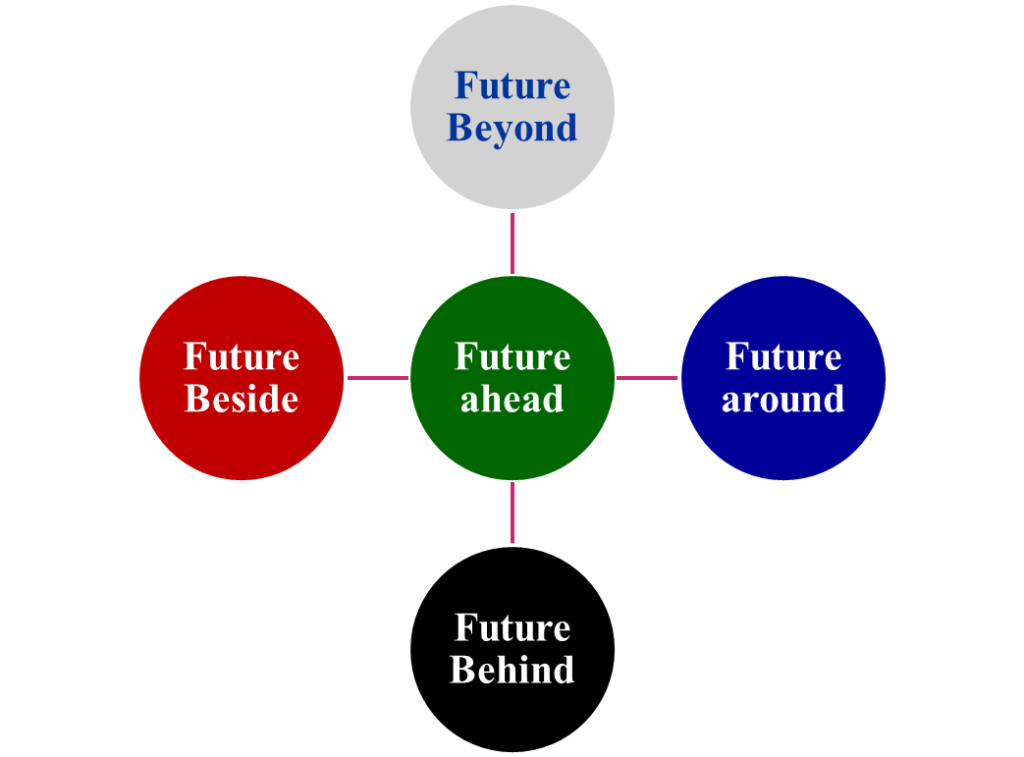5 Futures
The 5 Futures
Many factors may be responsible for company’s failure, but poor planning and decision-making play a significant role. There is a school of thought that poor planning may be occasioned by outdated planning models that assume a predictable and stable operating environment. With the current turbulent and dynamic operating environment, there is need to adopt a novel planning models. To increase your predictive probability, you need to consider a planning model that looks at the future in five places; referred to as “The 5 Futures” or “Chameleon Model”.

1. The Future Around (Present):
The future around is the present – the “now.” The current reality or status quo consists of events that are happening, but may be amplified sooner or later. For example, today, you know that technology has changed and impacted many things, but you cannot ignore its rapidly-accelerating future impact on people and businesses. The SWOT (strengths, weaknesses, opportunities and threats) analysis model is predicated on the present and provides a very narrow and limited view. It assumes a predictable and stable environment, where everything will pane out as planned.
2. The Future Beside:
This consists of events or trends that are already happening in the lives of your contemporaries or competitors, but can eventually catch up with you if you do not anticipate them and prepare accordingly. These events may not be currently on your radar, but if you do not spot them early, they can catch you by surprise with ruinous consequences. For example, you can easily fall victim to social challenges affecting your age mates and workmates. In business, you are cautioned never to ignore the challenges or achievements of your competitors, as they can easily spill over to you.
Exploring adjacent events will enable you to quickly assess the possibility of being affected as well, and guide you to be proactive in managing or fending them off. It is argued that Nokia, with its impressive quality in technology, failed to study and take note of what competition was doing. The rest is painful history as remarked by the former Chief Executive Officer, Mr. Olli Pekka, who said ‘we did not do anything wrong, but somehow, we lost.’ As pioneers in mobile phone technology, Nokia believed they were too good to be bothered by what competition was doing.
Failure always precedes success. If you are gainfully employed, consistently scan your environment within and without the company, searching for potential threats and opportunities. The same applies to business owners. Lately, many businesses run by hardworking and disciplined individuals have been wiped out by innovative competitors.
3. The Future Ahead:
The future ahead is a future that has already started, but has not yet arrived. It is like an aircraft that has left the airport, but has not arrived at its intended destination.
You can predict that it will arrive if all goes well. Does that prediction in any way demonstrate prophetic acumen on your part? No. As long as the aircraft is following a specified flight path, it will eventually reach its destination if nothing drastic happens to disrupt its course. The future ahead comes with a predetermined ‘flight plan’ that allows you to foresee the eventual outcome, and can be projected by extrapolating the current events. This is what companies do in strategic planning and stockbrokers in selecting wining counters. What you are doing now is a precursor to what will happen tomorrow. Remember, today was the tomorrow of yesterday.
4. The Future Behind
The future behind is the past, which is static and frozen in time. Studying it provides references that give valuable insights into the future. The future behind provides a pattern for the interpretation of current events that can have future implications. The veracity of the past is that history has a way of repeating itself. Life is cyclic by nature.
As the earth goes around the sun, it comes back to the same place it was. It is not uncommon for you to make the same mistakes at certain intervals in your life. Career criminals tend to commit the same crimes over and over again. Some criminal justice systems jail such criminals for life to fend off repetition. In psychology, it is argued that past behavior is the best predictor of future behavior.
No prudent employer will hire new staff without investigating their past performance. A potential employer would want to know where the potential employee has been, with whom, doing what, and for how long.
If you reflectively analyze your past, you will be amazed at the wealth of lessons you can pick to guide you into the future. Traders at the stock exchange mine a lot of historical data and do comparisons to predict future trends of performing counters. The aviation industry is considered to be one of the safest by all standards, because every aviation accident is carefully investigated to get invaluable lessons to enhance future safety.
5. The Future Beyond:
The future beyond is one that is projectable because it comes with some predictable boundaries. It is the epitome of strategic visioning driven by the power of imagination.
It is seeing with the mind what the eyes cannot see. Events that come with known constraints make the eventual outcome almost inevitable. Parents begin investing in the education of their children early. All factors being constant, they believe the child will one day grow into a responsible adult who will be economically independent, and contribute to society. Though they cannot foresee the exact profession and rewards for the children, they
work towards this dream through strategic investment in education and other personal development initiatives. You perhaps epitomize this reality.
By looking at the five futures, you are borrowing from the chameleon’s visual talent. The traditional SWOT view of looking at the future from only one angle, that is, straight ahead, is no longer tenable. The failure of many corporate giants is indicative of the limitations in the SWOT model.
“We should be concerned about the future because we are heading there.” ~ Anonymous


